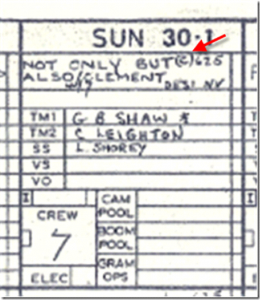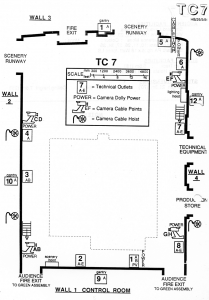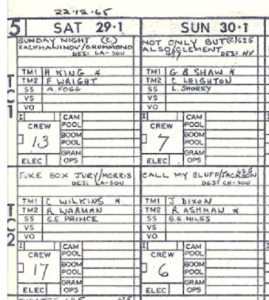“…According to http://www.tvstudiohistory.co.uk/tv%20centre%20history.htm#tc1
TC6 didn’t open until 1967, equipped from the start for colour….”
Tony Grant
When I joined in 1963, studios TC2 and TC3 had Marconi’s, and TC4 and TC5 had EMI’s. All B&W, 4×3 (remember that?). Next to open was studio TC1 with EMIs). I don’t recall any of the other three, 6, 7, 8 being B&W. Certainly TC6 had the huge, heavy colour Marconi’s when it first opened, usually mounted on adapted Vinten peds with the enlarged ring steer, and always scheduled with an assistant tracker to help with their operation. I can’t ever remember any of us making use of their services though. Whilst on crew 2, we did the first colour dramas in the studio (TC6), an Alan Plater trilogy, “There and Back, To See How Far It Is”, starring Norman Rodway and Nigel Davenport, sorry, again no dates. (David Brunt: The Plater trilogy was broadcast on BBC2 1,on 8th and 15th January 1968)
Whilst we’re having a good old memory dredge, I am ashamed to admit that I can’t remember the name of the wonderful Irish lady who dispensed tea in the Red tea bar, my home from home during these formative years. Yes, she occasionally worked in Blue, but I have many fond memories of the Red bar with her knowing just how I liked my tea. Green was never up to the standard of the others, IMHO.
Dick Blencowe
When I started at TVC in April 1965, it ended at TC5. The extension to include TC6, TC7 and TC8 was only girders.
Peter Neill
When I joined in 1964, TCs 1-5 were operational (B&W 405/625) and a couple of years later my crew was involved in proving tests for TC7—also B&W. TC 6 and TC8 followed, debuting in colour. The other studios were converted later I think all were done by the time BBC-1 went colour. I don’t know if all were 525 capable but I certainly remember “Charley’s Aunt” (with Danny La Rue) being done in 525 from TC6. I’m sure Martin Kempton’s site will have chapter and verse.
Bernie Newnham
When I arrived in Sept 1966, TC6 was a closed off exit from the blue tea bar. the other entrance was a wall. TC7 was operational with Marconi Mk4s, and as for TC8 – I didn’t know it was there, it was just walled off. TC6 came in to service with Marconi Mk7s and the big ped rings in 1967, as Martin says in his history of TV studios in London, with TC8 close behind also with Marconis. Soon enough, all three studios, 6,7 and 8 had EMI 2001s, probably in 1968. I worked on the proving test of one of them.
John Howell (Hibou)
The first mention in my diary of the ‘trio’ of TCs 6 7 & 8 (they shared a VAR) was TC7 in May 1966: "Suivez La Piste"
Alec Bray
Studio TC7 was up and running in B&W by mid 1965.
But now, here’s a conundrum.
Ever since I left the BBC in 1967, I have remembered “Not Only…But Also” as being recorded in Studio TC7: it was not telerecorded in TC3 or TC4. TC5 was exclusively used for Schools programmes at the time – and “Not Only…But Also” was NOT done in TC2.
In whichever studio was used, the Audience portable seating was put down the LONG side of the studio, that is, from the dressing room end to the outer ring end. This was completely different to the set up in the studios TC2 – TC4 where the audience portable seating was set across the studio, under the gallery (which makes sense as the gallery people could still see all the sets).
Now, it is possible that the studio used was TC7.
From Martin Kempton’s website http://www.tvstudiohistory.co.uk:
“…TC7 was almost exactly the same design as TC2 and TC5 (and also with long lighting bars) although it was a couple of feet longer. According to the SMPTE Journal it opened on 4th July 1965. ….. It originally had black and white Marconi MkIV cameras but was colourised with Marconi Mk VII cameras in 1967…”
But TC7 was a small studio – not much bigger than TC2 or TC5. LE in a small studio (223 square metres (2,400 ft²))?
Well, according to one website, http://www.astra2sat.com/basic-page-2/bbc-television-centre/, TC7 hosted, among other programmes, “Butterflies” and “To the Manor Born”, So it is quite possible that “Not Only….But Also” was recorded in Studio TC7.
While on the subject of “Not Only… But Also”…
During one recording of “Not Only….But Also” there was an ad-lib by Dudley More, Slightly naughty, so cover eyes and ears if easily offended.
It was a Pete ‘n’ Dud sketch. Pete was already in the room (set), and the sketch started with Dud coming into the room, crossing to Pete and starting the dialogue. For some reason there was a flipchart and pens as part of the set/sketch. SO, cue.. and Dud comes into the room, crosses to the flip chart, and scrawls on it:
M W M W M M M
in a curvy script. something like this:
“Bum, titty, bum, titty, bum bum bum, ” he said in Dud’s voice, “I just thought of that!”
(Click on the picture below to see larger version:
use your Browser’s BACK button to return to this page)
On another occasion – may be for the Christmas edition – as we came to start the stagger though (now called “blocking?”) – Pete and Dud said that they had only finished writing the script at 4:00 am that morning!
David Brunt
NOBO didn’t go much in the way of sets. Probably a music area where the links were also done from and perhaps one or two sketch areas with small sets for two-handers (the Pete and Dud sketches probably ran ten minutes or more each). I can see it fitting in a small studio quite well.
John Howell (Hibou)
There is an established convention to refer to the studio walls:
Wall 1 contains the control rooms, then Walls 2, 3, and 4 continue clockwise.
I was quite surprised to find in the studios facilities write-up done by Harry Bradley in 1986 that TC7 audience rig has 160 seats, (see dotted area on the attached floor plan), not much floor space left for the sets! Maybe the original rig wasn’t so big.
(Click on the picture below to see larger version:
use your Browser’s BACK button to return to this page)
Roger Francis
Normally the audience seating in TC1 does run from the dressing room end to the outer ring road end that is, along Wall 2. In about 1990 when the studio had a major refurbishment, permanent seating was installed along that wall (wall 2). This seating is accessed by an audience entrance at gallery floor level and is collapsable against wall 2 when not needed. Permanent audience monitor hoists over it were also installed with monitors normally left on them. Permanent audience mic points and PA speaker sockets were also installed on the lighting bars.
Very rarely audience seating is brought in and placed along wall 1 in front of the gallery. This is a pain because it obstructs the entrance to the tech ops store which is under the gallery. When this happens part of the temporary audience seating has to be put in after the camera rig or arrangements have to made for technical equipment brought out of the store the day before.
So it is possible that the “Not Only… But Also” was shot in TC1
Peter Neill
Any LE shows I worked on in TC1 (including a series of NOBA with crew 7) had the audience seating at right angles to the gallery wall. As did the last programme I attended there — as an audience member — "Goodbye Television Centre", in the company of Roger Bunce and Arthur Hayes (one of the original architectural team).
So, I’m sure “Not Only … But Also” was TC1.
Dave Plowman
It’s fairly normal for many audience shows to have the audience along the ‘long’ wall if the studio isn’t square. Allows more sets visible in a sit-com, etc. Things with only the one set – like say a concert – may prefer a deeper stage. Or a chat show – where you want the audience not to be too far from the talent. That seemed to be the rule at Teddington 1 – where it didn’t much matter which way round it was in terms of rigging, etc.
Dave Mundy
I worked on a ‘Fawlty Towers’ in TC1 when the audience rostrum was along the LH wall ie. from the sound gallery to the ring-road. Certainly, all the sit-coms in TC3 and TC4 were under the galleries and TC8, being built in, had to be!
Clive Doig
I was the AFM on “Not Only…But Also” Series 2, Roger Race the AP, Dick Clement the Director/Producer. My duties had consisted of volunteering to be thrown into Bodiam Castle moat during the filming of “I Claudius”, with Pete and Dud and Claire Bloom, and with trying to prise Dudley Moore out of the Make Up room, before each studio sketch! I can confirm that the series was recorded in TC1 with the audience seating from Wall 1 to Wall 3, Gallery wall to ring road wall.
[A scan of a TODS for 22-12-1965 shows NOBA in Studio TC1]
(Click on the picture below to see larger version:
use your Browser’s BACK button to return to this page)
Roger Francis
(Click on the picture below to see larger version:
use your Browser’s BACK button to return to this page)

The letter C between NOBA and 625 in the TODS related to the category of production.
Shows in TC1 were rated A, B or C.
C rated productions were planned and costed to be done in TC3, TC4, TC6 or TC8. As such when they ended up in TC1, because it was convenient for programme planning, they were not allowed to use the full studio. They could only use the same floor area as they would have had in 3,4,6 or 8 and couldn’t build their sets any higher. If I remember rightly, TC1 has 2 cyc rails, one at the same height as 3,4,6 and 8 and one at the full height of the studio. Category C productions were only allowed to use the lower rail. I think the whole thing was to stop shows that were not budgeted for TC 1 getting the extra size for free.
I always had the impression that Blue Peter had an exemption from this. If they had vehicles coming into the studio then the main set would need to be at the gallery end but they would still need to use the scene door end. As they probably didn’t know what was in the show when programmes were allocated to studios this would make sense.
Category A productions were planned and costed to use the full studio.
Category B productions were a bit of a mystery to me. I think they were allowed to use to full floor area but not the height or vice versa.
I always thought it strange that there wasn’t a category D for shows planned and costed for TC2, TC5 or TC7. It was not uncommon for these shows to end up in TC1. I’ve done many with the set in one corner of the studio. Indeed the first show I lit was “Panorama” in TC1 in the corner between walls 2 and 3.
So that NOBA would be a category C production in TC1.
Pat Heigham
I have some 8mm cine of the (hush) “Black & White Minstrels” when colour was introduced to TC1 (probably 1966-1967?) and the acting area was down the long side to the right of the galleries. Thus the audience rostra was along Wall 2.
I agree that TC3 and TC4 had the foldable audience seating under the gallery windows, so we could view the sets. (David Croft used to come in and lie down behind the sound desk and view through the window, of the shows he’d written, but not directed).
TC6 – I recall working on a costume drama in colour, I think, “Portrait of a Lady" prior to 1968 when I departed to the Film Industry. Also a play set during WW1, with the PEG in the sound gallery (Programme Effects Generator!) That should trigger a few memories! I found it quite a useful device, as effects could be instantly played in accurately against dialogue, dependent according to the actors’ playing.
I wish I had kept a diary, like some other respondents here, but I never did. The book I might write, one day, with my toes in a Caribbean beach and a Planter’s Punch at my elbow, will have to rely on memories! (Well, Ian Fleming made it successfully!)
Geoff Fletcher
I worked on “Portrait Of A Lady” in TC6. I was on Dave Mutton’s Crew 14 and it was our first drama in colour. We started on Thursday 7th December 1967 and did six episodes – one episode a week, each one over two days, until 26th/27th January 1968. TC6 had the big Marconi colour cameras on peds with extended ring steers. They were supposed to be operated by two guys but none of us ever did that. It was a joy to work on – the cast was amazing, and included Richard Chamberlain, Suzanne Neve, James Maxwell, and the Gurneys – mother and daughter, plus several other well known UK and US names. When Richard Chamberlain first came onto the studio floor some wag in Sound played the “Kildare” theme over the PA – he took the joke with good humour. We all got very much into it as the weeks went on. I remember Dave Mutton doing a difficult and complicated shot around the bed during Richard Chamberlain’s death scene in the last episode. It was a highly emotional leave-taking between Richard and Suzanne. The studio was silent until somebody dropped a pencil or something – it sounded like a can of nails, and the spell was broken. It all stopped and Dave was very annoyed, as were Richard and Suzanne and all the rest of us crew. At the end, there was a terrific party at Carlo’s Place in Fulham Palace Road to which all were invited. Happy memories.
Another memory of TC6 – attempting the grand traverse (difficult – moderate exposure with thin holds) with Ken Major. (See “The Climbers Guide to Television Centre” by K.S.Major – Penguin 10/6)
David Brunt
I made copies of some Duty Sheet pages when I was at the Written Archive in Caversham.
I’ve got one for a week in April 1967 and another for June 1967 and TC6 isn’t included for either week, so it wasn’t in service at that point.
TC1 and TC7 were up and running (“Theatre 625” and “Top of the Form” in April, among others: crews 6 and 16).
Geoff Fletcher
The earliest personal date I have for working in TC6 is Monday 11 September 1967. – Crew 14 with Dave Mutton Senior Cameraman, prog was "Hand Me My Sword, Smith!".
It was the first day of a working to Schedule and SRs – industrial action by ABS.
| Tuesday 12th September1967 | Notes |
| Work – a late finish. First day of working to Schedule and SRs. Very wearing sticking to it – against all our training and instinct. Drank a lot of lager at lunch and dinner. I like the new crew – good atmos. Pete Ware dropped in to see how things were going. More drinks in the Club at night with the Director. … |
0 Miles TC6: Hand Me My Sword, Smith! Crew 14 – Dave Mutton |






